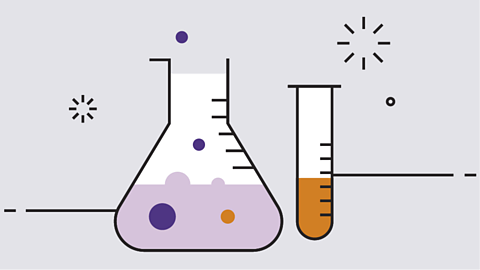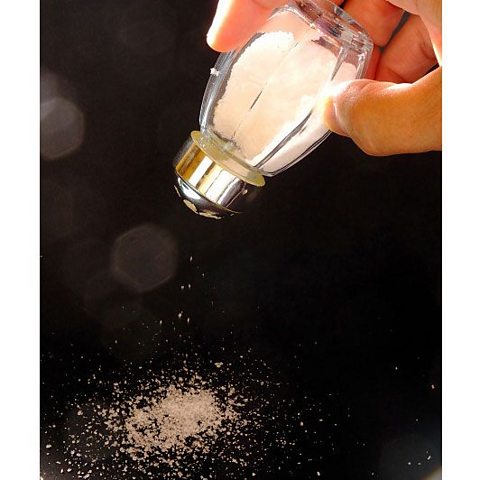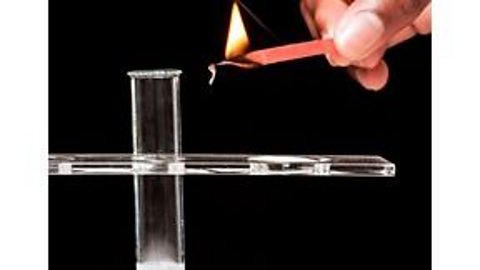Key points
- An acid and alkali will neutralise each other and produce a salt and water. This is called a neutralisation reaction.
- The name of the salt produced can be worked out from the names of the acid and the alkali.
- Chemical equations can be written to describe a neutralisation reaction.
What pH would a neutral solution have?
A pH of 7 means a solution is neutral. Anything below pH 7 is an acid, and anything above pH 7 is an alkali.

Video - Acid plus alkali reactions
Watch this video to find out more about neutralisationA chemical reaction in which an acid reacts with a base or an alkali to form a salt and water. reactions.
While you're watching, try to listen out for as many acidA substance which produces hydrogen ions in solution. Acids have pH values lower than 7. and alkaliA special type of base which dissolves in water to produce hydroxide ions. Alkalis have pH values higher than 7. as you can, and the names of the salts they produce.
Miss Fong: Today we're talking about chemical reactions and, in particular, what happens when acids and alkalis mix with each other.
Katie: OK. So where do we start?
Miss Fong: Well, first up let's remind ourselves about the properties of acids and alkalis.
This is the pH scale.
Katie: Oh, I remember this. OK, so we've got acids on the left there and they have a pH range from 0 to 6, where 0 is the most acidic and 6 is the least acidic. Is that right?
Miss Fong: Yep. And the alkalis are on the right of the pH scale, ranging from 8 to 14, where 8 is the least alkaline and 14 is the most alkaline.
Katie: OK. So, what happens when acids and alkalis meet? Is there a reaction?
Miss Fong: Yes. And the reaction always produces two things - water and salt.
Katie: Salt… As in the salt that you put on your chips?
Miss Fong: No. Nothing mixed in a science lab should be eaten. Some salts are odd colours and even poisonous.
Katie: OK, so when acids meet alkalis, the chemical reaction produces water and a salt of some kind, Miss?
Miss Fong: Indeed. The exact salt that is produced is dependent on which acid and which alkali you are mixing.
Katie: Oh I feel an example coming on.
Miss Fong: Yes.
Let's imagine we are mixing a common acid like nitric acid and a common alkali - sodium hydroxide. When they react water and a salt called sodium nitrate is produced.
Katie: Oh, OK. So, does sodium nitrate have any uses by the way? What is it?
Miss Fong: Yes. In industrial settings they're used for fertilisers and as food preservatives. Look at sodium nitrate. The first half comes from the alkali and the second half comes from the acid. So, it becomes sodium nitrate.
Katie: How come it's nitrate or not nitric?
Miss Fong: Well, you'll see that the acid changes its name slightly when it forms salt. Nitric becomes nitrate, hydrochloric acid becomes a chloride and sulphuric acid becomes a sulphate.
Katie: OK so it's nitrates, chlorides and sulphates?
Miss Fong: Good. Shall we put your new found knowledge to the test?
Katie: Oh go on then. I thought this might be coming, Miss. You guys can play along at home too.
Miss Fong: Great. So, in your hands, Katie, you've got a list of acids and then I have a list of alkalis. So, when I say go we see which ones we have and then you try and make the salt name.
Katie: OK.
Miss Fong: Ready.
Katie: Yeah I'm ready.
Miss Fong: Three, two, one go.
Katie: Sulfuric acid.
Miss Fong: And potassium hydroxide.
Katie: Oh OK. So the salt produce would be potassium sulfate.
Miss Fong: Super. OK you ready for the second one?
Katie: Yes.
Miss Fong: Three, two, one go.
Katie: Hydrochloric acid.
Miss Fong: And sodium hydroxide.
Katie: Oh OK. So the salt produced is sodium chloride.
Miss Fong: Super. OK, the final one. Are you ready?
Katie: Yes.
Miss Fong: Three, two, one.
Katie: Nitric acid.
Miss Fong: And lithium hydroxide.
Katie: OK. So the salt produced would be lithium nitrate.
Miss Fong: Super. All correct.
Katie: Ah. That was intense, but fun. I liked that game. Now, I know my acid alkali reactions so much better. Thank you very much, Miss Fong.
What are the names of the substances formed in a neutralisation reaction?
A salt and water.
Neutralisation reactions
A chemical reactionWhen chemical bonds are broken and made between atoms, so that new substances (compounds or elements) are made. happens if you mix together an acid and a baseA substance which neutralises an acid. . The reaction is called neutralisation. A neutralA substance that is not acidic or alkaline. solution is made if you add just the right amount of acid and base together.

Did you know?
Usually neutralisation is an exothermicA physical change or chemical reaction that transfers energy to the surroundings. reaction, so the reaction mixture warms up during the reaction.

Naming the salt
Video - Names of salts
Watch this video to learn more about how salts are named.
VOICEOVER: Acid plus alkali reactions
An acid can be neutralised by adding it to an alkali to make a salt and water. Alkalis are most commonly metal hydroxides such as sodium hydroxide.
The three acids most commonly used in chemistry are nitric acid, sulfuric acid and hydrochloric acid.
When an acid and an alkali react the two products produced a salt plus water. When an acid alkali neutralisation reaction happens - like when adding sodium hydroxide to sulfuric acid - it produces sodium sulfate and water. The name of the salt is made by taking the first part from the alkali - sodium. And the second part from the acid - sulfuric.
Sodium sulfate.
Nitric acid makes salts ending with nitrate. Sulfuric acid makes salts ending with sulfate. And hydrochloric acid makes salts ending with chloride.
saltA compound which has atoms of metals and non-metals chemically bonded. have scientific names. For example, the scientific name of table salt is sodium chloride.
Names of salts can be worked out from the names of the acid and the alkali that react to make them.
There are two parts to a salt name:
- The first word is a metal, taken from the alkali.
- The second word ends in ~ide or ~ate, taken from the acid.

For example, table salt – or sodium chloride - is produced when hydrochloric acid reacts with the alkali sodium hydroxide. The word sodium is taken from the alkali, and the word chloride from the acid.
hydrochloric acid + sodium hydroxide → sodium chloride
Alkalis are typically metal hydroxides, such as the sodium hydroxide used to make table salt.
There are three acids that are commonly used. These are hydrochloric acid, nitric acid, and sulfuric acid.

These three acids use different words for the name of salts produced by them:
- A salt made from hydrochloric acid will end in chloride
- A salt made from nitric acid will end in nitrate
- A salt made from sulfuric acid will end in sulfate
Can you work out the name of the salt made from potassium hydroxide and hydrochloric acid?
Potassium chloride.


Did you know?
Working backwards, the names of the acid and alkali reacting can be predicted from the name of the salt.
For example, the salt lithium nitrate would have been made from lithium hydroxide and nitric acid.

The second word in the name of a salt comes from which of the reactants?
The second word of the name is taken from the name of the acid.
For example:
Hydrochloric acid → chloride
Nitric acid → nitrate
Sulfuric acid → sulfate
Describing neutralisation reactions using equations
Word equations
Neutralisation reactions can be described using chemical equationA way of describing chemical reactions in words or symbols. like a word equation. This uses the scientific names for the acid and alkali placed on the reactantThe chemical present at the start of a reaction. Reactants appear on the left of a chemical equation, before the arrow →. side of the equation. The scientific name for the salt goes on the productA chemical which is made in a chemical reaction. Products are written on the right of a chemical equation, after the arrow (→). side, together with water.
For example:
Nitric acid + sodium hydroxide → sodium nitrate + water
Acid + alkali → salt + water
Symbol equations
A symbol equation describes a reaction more precisely using chemical symbols and formulas. Here is an example of a word equation and a symbol equation describing the same reaction.
Nitric acid + sodium hydroxide → sodium nitrate + water
HNO₃ + NaOH → NaNO₃ + H₂O
Acids always have hydrogen (H) in them. For example, hydrochloric acid has the formula HCl, sulfuric acid is H₂SO₄ and nitric acid as shown in the example is HNO₃.
Alkalis usually have the hydroxide group OH in their formula, such as the sodium hydroxide (NaOH) in the example.
The symbol equation is helpful in seeing where the water came from.
The H from the acid combines with the OH from the alkali to make the water (H₂O). The other elements are used in making the formula of the salt.
What name is given to the substances made in a chemical reaction?
Products.
For example, salt and water are the products of a neutralisation reaction.
Test your knowledge
Quiz
Teaching resources
On the lookout for more resources to get your students excited about chemistry? In this video from BBC Series Chemistry Bites, science presenter Jon Chase breaks down acids, alkhalis and indicators.
BBC Teach has thousands of free, curriculum-linked resources to help deliver lessons - all arranged by subject and age group.
GCSE exam dates 2025
Find out everything you need to know about the 2025 GCSE exams including dates, timetables and changes to exams to get your revision in shape.

More on Acids and alkalis
Find out more by working through a topic
- count3 of 3

- count1 of 3
